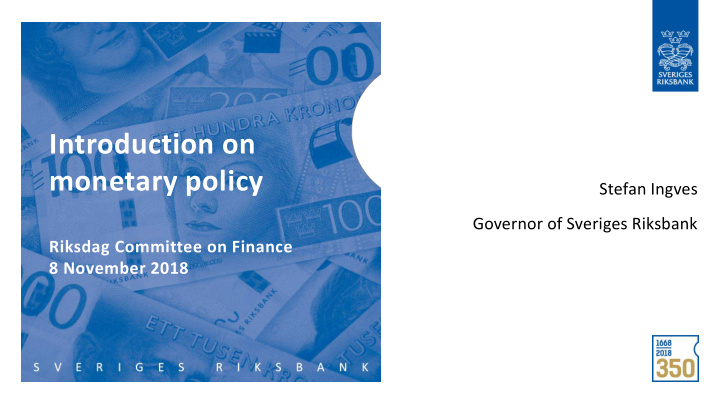



Introduction on monetary policy Stefan Ingves Governor of Sveriges Riksbank Riksdag Committee on Finance 8 November 2018
Favourable international economic activity Good GDP growth Unemployment has fallen 14 14 United States Euro area 12 12 10 10 8 8 6 6 4 4 2 2 0 0 01 04 07 10 13 16 Annual percentage change and per cent. Sources: Bureau of Economic Analysis, Eurostat, national sources, OECD and the Riksbank
The US – first in the economic cycle Core inflation moderate in the euro area The US – ahead in the rate-rise cycle 2.5 2.5 2.0 2.0 1.5 1.5 1.0 1.0 0.5 0.5 United States Euro area 0.0 0.0 11 13 15 17 Core inflation in the euro area is measured as the HICP excluding food, tobacco, alcohol and energy. In the US, it is measured as PCE excluding food and energy. Source: Bureau of Economic Analysis, Eurostat, Interest rates refer to the fed funds rate for the US, bank rate for the UK, sight deposit rate for Norway and deposit for the euro area. Broken lines show forward rates for expected overnight rate for 5 November 2018. national central banks, Macrobond and the Riksbank Yellow broken line refers to Norges Bank’s policy rate forecast from 20 September 2018.
Uncertainty about international prospects Sustainability of public finances in Italy Escalated trade conflict between the US and China Brexit Unease in some emerging market economies, e.g. Turkey and Argentina
Swedish economy has grown rapidly compared with other countries GDP level Index 2007 = 100, seasonally adjusted data Sources: The Bureau of Economic Analysis, Eurostat and Statistics Sweden
Expansionary monetary policy has helped CPIF inflation has recovered Inflation expectations back at 2 per cent Annual percentage change. Vertical broken line indicates when a negative Source: Statistics Sweden and TNS Sifo Prospera repo rate was introduced and government bond purchases were initiated. Inflation expectations among money market participants, average.
Moderate inflationary pressures 4 4 Median CPIF, outcome September 3 3 2 2 1 1 0 0 -1 -1 01 04 07 10 13 16 Annual percentage change. The field shows the highest and lowest Sources: Statistics Sweden and the Riksbank outcomes among different measures of underlying inflation. The line represents the median of these measures.
Strong Swedish economic activity Calmer GDP growth... ...but high pressure on the labour market Annual percentage change for GDP growth. Shortage figures derived Sources: Statistics Sweden, the Riksbank and the National Institute of from the proportion of firms responding yes to the question of Economic Research whether there is a labour shortage.
Inflation close to target, energy prices providing a boost Good conditions for inflation close to 2 per cent 3 3 Energy prices' contribution to the CPIF CPIF Continued good Swedish economic activity 2 2 Rising cost pressures 1 1 Inflation expectations at 2 per cent Gradually higher inflationary pressures abroad 0 0 -1 -1 11 13 15 17 19 21 Note. Annual percentage change. Sources: Statistics Sweden and the Riksbank
If inflation prospects hold up, it will soon be appropriate to slowly raise the repo rate Per cent Source: The Riksbank
Challenges remain... Inflationary pressures have been low for a long time Despite economic boom - difficult for some to establish a foothold on the labour market Difficult to find housing where the jobs are Household indebtedness - a long-standing problem
Recommend
More recommend